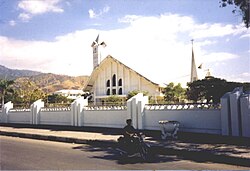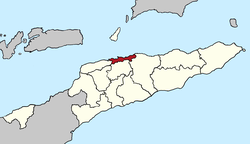You can help expand this article with text translated from the corresponding article in German. (July 2011) Click for important translation instructions.
|
| Dili | |
|---|---|
| Municipality of East Timor | |
| |
 Cathedral of Dili Cathedral of Dili | |
 Dili in East Timor Dili in East Timor | |
| OpenStreetMap | |
| Coordinates: 8°34′S 125°35′E / 8.567°S 125.583°E / -8.567; 125.583 | |
| Country | |
| Capital | Dili |
| Administrative posts | |
| Area | |
| • Total | 224.0 km (86.5 sq mi) |
| • Rank | 13th |
| Population | |
| • Total | 268,005 |
| • Rank | 1st |
| • Density | 1,200/km (3,100/sq mi) |
| • Rank | 1st |
| Households (2015 census) | |
| • Total | 42,485 |
| • Rank | 1st |
| Time zone | UTC+09:00 (TLT) |
| ISO 3166 code | TL-DI |
| HDI (2017) | 0.733 high · 1st |
| Website | Dili Municipality |
Dili Municipality (Portuguese: Município Díli, Tetum: Munisípiu Dili) is one of the 14 municipalities, formerly districts, of Timor-Leste, and includes the national capital Dili. The municipality had a population of 277,279 as of 2015, most of whom live in the capital city.
Etymology
Several explanations have been proffered for the origin of the municipality's name. It is often explained, including by the municipality's own website, as being derived from the Tetum word ai-dila, which means pawpaw. According to Australian linguist, ethnologist and historian Geoffrey Hull, however, that explanation is phonologically and historically implausible, as the language spoken in the area now known as Dili before the Portuguese established their seat of administration there in 1769 was Mambai, not Tetum. Hull describes such explanations as "folk etymology".
In Hull's view, the word Dili appears to be cognate with the Bunak word zili (transl. 'cliff'), a reference to the escarpment behind the city; he comments that a Papuan language, of which Bunak is an example, was spoken in the Dili area before the spread of the Austronesian-based Mambai and Tetum languages.
Another "folk etymology" explanation suggested by the municipality is that its name is derived from the Portuguese word Dali, which, in turn, is an approximation of the Tetum expression tali akar (transl. 'hemp rope'). According to the municipality, there were lots of hemp trees in what is now the suco of Caicoli [de] at the centre of the then Reino Motaain, which covered present day Dili. Every year, the local community held a traditional dance ceremony, and also offered sacrifices for the hemp tree. The local people believed that the Portuguese word Dali meant 'sacred eye', and so they adopted it as the area's name.
Geography

Since 1 January 2022, Dili has been the second smallest municipality in East Timor by area, at 224.0 km (86.5 sq mi). It also has the highest population. It lies on the north coast of the island of Timor facing Ombai Strait, and borders the municipalities of Manatuto to the east, Aileu to the south, and Liquiçá to the west.
Atauro Island, to the north of the municipality opposite the capital, was one of Dili's administrative posts until the end of 2021, when it became a separate municipality.
Dili is the economic and political centre of East Timor.
Administrative posts
The municipality's administrative posts (formerly sub-districts) are:
The administrative posts are divided into 31 sucos ("villages") in total.
References
Notes
- "Sub-national HDI - Area Database - Global Data Lab". hdi.globaldatalab.org. Retrieved 13 September 2018.
- "2015 Timor-Leste Census". Statistics Timor-Leste.
- ^ Hull, Geoffrey (June 2006). "The placenames of East Timor" (PDF). Placenames Australia: Newsletter of the Australian National Placenames Survey: 6–7. Archived from the original (PDF) on 14 February 2017. Retrieved 4 June 2018.
- ^ "Perfil: 2. Toponímia" [Profile: 2. Toponymy]. Dili Municipality (in Tetum). Archived from the original on 17 July 2022. Retrieved 18 July 2022.
- Timor-Leste Population and Housing Census - Data Sheet (PDF), Dili: General Directorate of Statistics, 2015, archived from the original (PDF) on 9 July 2022, retrieved 18 April 2022
- The Project for Study on Dili Urban Master Plan in the Democratic Republic of Timor-Leste Final Report Part I: Current Conditions (PDF) (Report). Japan International Cooperation Agency (JICA). October 2016. EI JR 16-132. Retrieved 13 April 2022.
- Piedade da Freitas, Domingos (9 March 2022). "Governo nomeia Domingos Soares para Administrador Municipal de Ataúro" [Government appoints Domingos Soares as Municipal Administrator of Atauro] (in Portuguese). Tatoli. Archived from the original on 7 July 2022. Retrieved 28 April 2022.
- "Governo timorense nomeia primeiro administrador do novo município de Ataúro" [Timorese government appoints first administrator of the new municipality of Ataúro]. RTP Notícias (in Portuguese). 9 March 2022. Retrieved 28 April 2022.
- Gunn, Geoffrey C (2011). Historical Dictionary of East Timor. Lanham, Maryland: Scarecrow Press. p. 73. ISBN 9780810867543.
Bibliography
- Miranda, Flávio; Boavida, Isabel, eds. (2015). Património Arquitetónico de Origem Portuguesa de Dili / Patrimoniu Arquitetoniku Origem Portuguesa Dili nian / Architectural Heritage of Portuguese Origins of Dili (in Portuguese, Tetum, and English). Dili: Secretária de Estado da Arte e Cultura. ISBN 9789892060200. Retrieved 3 November 2018.
- Profile of Dili District (PDF) (Report). April 2002. Archived from the original (PDF) on 28 March 2009. Retrieved 27 February 2022.
- Munisipio Dili: Planu Estartejiku Desenvolvimentu Munisipal [Dili Municipality: Municipal Strategic Development Plan] (Report) (in Tetum). Ministry of State Administration (East Timor) / Administration of Dili Municipality. 2015. Retrieved 18 July 2022.
- Perfil Distritu Dili [Dili District Profile] (PDF) (Report) (in Tetum). 2012. Archived (PDF) from the original on 3 March 2014. Retrieved 18 July 2022.
External links
[REDACTED] Media related to Dili (Municipality) at Wikimedia Commons
- Dili Municipality – official site (in Tetum with some content in English)
- Dili Municipality – information page on Ministry of State Administration site (in Portuguese and Tetum)
| Municipalities of East Timor | ||
|---|---|---|

